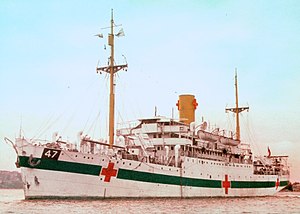AHS Centaur

AHS Centaur following her conversion to a hospital ship. The Red Cross designation "47" can be seen on the bow.
|
|
| History | |
|---|---|
|
|
|
| Name: | Centaur |
| Namesake: | The Greek mythological creature |
| Owner: | Ocean Steamship Company |
| Operator: | Alfred Holt & Co Ltd (Blue Funnel Line) |
| Ordered: | 1923 |
| Builder: | Scotts Shipbuilding and Engineering Company, Greenock |
| Laid down: | 16 November 1923 |
| Launched: | 1924 |
| Completed: | 29 August 1924 |
| Homeport: |
|
| Identification: | United Kingdom Official Number 147275 |
| Fate: | Transferred to Australia |
| General characteristics as merchant vessel | |
| Tonnage: | 3,222 gross tonnes |
| Length: | 96 m (315 ft) |
| Beam: | 14.7 m (48 ft) |
| Draught: | 6.1 m (20 ft) |
| Propulsion: | Single screw; 4-stroke, 6-cylinder Burmeister and Wain diesel oil engine providing 1,400 bhp (1,000 kW) |
| Speed: | 12.5 knots (23.2 km/h; 14.4 mph) |
| Capacity: |
|
| Crew: | 39 officers, 29 ratings |
| Armament: |
|
| History | |
|
|
|
| Name: | Centaur |
| Operator: | 2nd Australian Imperial Force |
| Acquired: | 4 January 1943 |
| Reclassified: | Hospital ship |
| Homeport: | Sydney, New South Wales |
| Identification: | Red Cross Ship 47 |
| Fate: | Torpedoed on 14 May 1943 by Japanese submarine I-177 |
| General characteristics as hospital ship | |
| Capacity: | 252 |
| Crew: | 75 crew, 65 permanent Army medical staff |
| Armament: | All weapons removed, degaussing equipment remained |
Australian Hospital Ship (AHS) Centaur was a hospital ship which was attacked and sunk by a Japanese submarine off the coast of Queensland, Australia, on 14 May 1943. Of the 332 medical personnel and civilian crew aboard, 268 died, including 63 of the 65 army personnel.
The Scottish-built vessel was launched in 1924 as a combination passenger liner and refrigerated cargo ship and operated a trade route between Western Australia and Singapore via the Dutch East Indies (now Indonesia), carrying passengers, cargo, and livestock. At the start of World War II, Centaur (like all British Merchant Navy vessels) was placed under British Admiralty control, but after being fitted with defensive equipment, was allowed to continue normal operations. In November 1941, the ship rescued German survivors of the engagement between Kormoran and HMAS Sydney. Centaur was relocated to Australia's east coast in October 1942, and used to transport materiel to New Guinea.
In January 1943, Centaur was handed over to the Australian military for conversion into a hospital ship, as the ship's small size made her suitable for operating in Maritime Southeast Asia. The refit (including installation of medical facilities and repainting with Red Cross markings) was completed in March, and the ship undertook a trial voyage: transporting wounded from Townsville to Brisbane, then from Port Moresby to Brisbane. After replenishing in Sydney, Centaur embarked the 2/12th Field Ambulance for transport to New Guinea, and sailed on 12 May. Before dawn on 14 May 1943, during her second voyage, Centaur was torpedoed and sunk by a Japanese submarine off North Stradbroke Island, Queensland. The majority of the 332 aboard died in the attack; the 64 survivors were discovered 36 hours later. The incident resulted in public outrage as attacking a hospital ship is considered a war crime under the tenth 1907 Hague Convention. Protests were made by the Australian and British governments to Japan and efforts were made to discover the people responsible so they could be tried at a war crimes tribunal. In the 1970s the probable identity of the attacking submarine, I-177, became public.
...
Wikipedia
